In Brief...
- The SAUSD school board voted 4-1 to lay off—at minimum—351 employees, including 169 teachers and 57 counselors in order to avoid budget deficits that would render the Board irresponsible and taken over by the County or State. The District could not say what the max amount of staff layoffs could be.
- Speakers voiced opposition Tuesday and instead ordered the Board to cut the Superintendent's pay, along with other high-paid non-management positions. Since the Item was 'pulled' by the Board, it wasn't taken for a vote. Those opposed say the District is sitting on $362 million is reserves which could be used, however it is required by law for Districts to have a certain percentage kept away in the event of bankruptcy.
- CBO Ron Hacker said that SAUSD is "not top heavy" and was rated one of the most efficient school districts around, and added they were not looking at making cuts to management, only to review all vacancies and determine to cut those or not.
- The way SAUSD positioned the timeline to be, which dates back to when Mayor Valerie Amezcua sat on the school board, attempted to make it clear to the community that the layoffs were imminent since day one (pre-COVID). Superintendent Almendarez added that the reason why cuts are being made now is because they cannot financially afford to anymore and the one-time funds used to pay their salaries have been used up.
SAUSD HQ — The Santa Ana Unified School District voted 4-1 (Magdaleno opposed) Thursday to approve its 'budget stabilization plan', clearning the way for layoffs off 351 certificated staff, including 169 teachers, after projecting hefty budget deficits exceeding $175 million alongside rapidly declining enrollment in schools.
According to resolution 24/25-3634, the District plans to address "financial challenges" faced by the district due to declining revenues, increasing costs, and the end of state and federal COVID relief grants, where cuts being made used one-time funds. Aside from those reasons, scores of parents are choosing to enroll their children to charter schools, further declining enrollment at the public school system.
Who's being let go?
Certificated Non-Management Staff:
Teachers: No fewer than 169 positions.
Counselors: No fewer than 57 positions.
Instructional Coaches: No fewer than 55 positions.
Curriculum Specialists: No fewer than 15 positions.
Itinerant (Elementary): No fewer than 21 positions.
Home Hospital Staff: No fewer than 5 positions.
Social Workers: No fewer than 9 positions.
Senior Social Workers: No fewer than 4 positions.
Teachers on Special Assignment: No fewer than 16 positions.
Classified Non-Management Staff:
All vacancies in this category will be reviewed, and positions will only be filled if deemed necessary to meet the instructional and operational needs of the district.
Management:
Management vacancies will also undergo a review process, with hiring decisions based on operational necessity.
The District will take a vote in late January or early February to let go a minimum of 169 teachers, 57 counselors, 55 instructional coaches, 15 curriculum specialists, 21 elementary itinerants, 5 home hospital staff, 9 social workers, 4 senior social workers, and 16 teachers on special assignments. There is no set maximum yet.
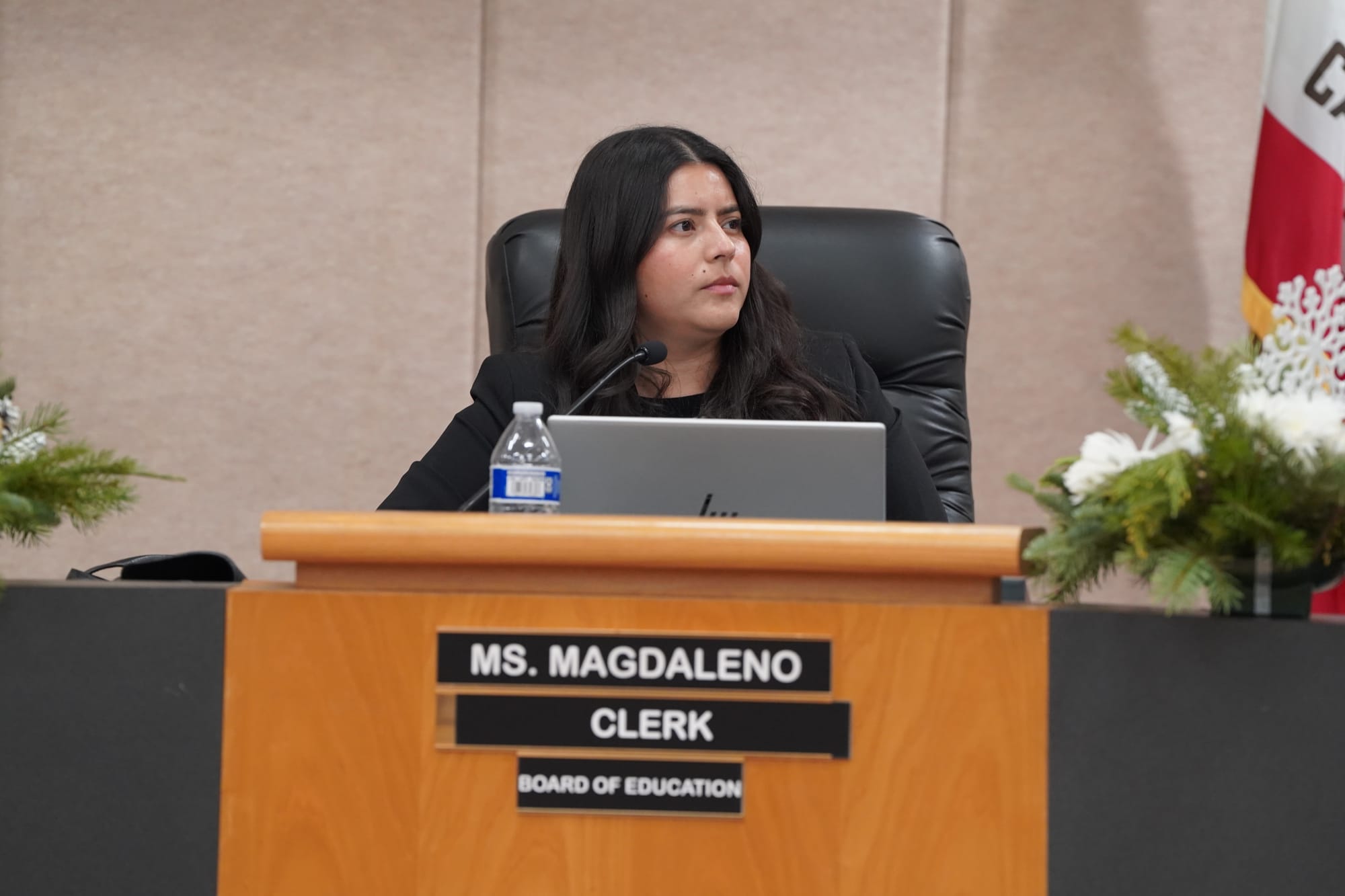
Newly elected board member and recently sworn-in on Tuesday, Valerie Magdaleno was the sole dissenting vote.
"As a new board member, this was an incredibly difficult decision, particularly because it directly affects the lives of our students, staff, and community," said Magdaleno. "I believe it is my responsibility to thoroughly understand the District's financial situation before making a decision of this magnitude. At this time, I did not feel confident that I had a complete understanding of the District's finances or that every possible solution had been fully explored to prevent the need for rightsizing."
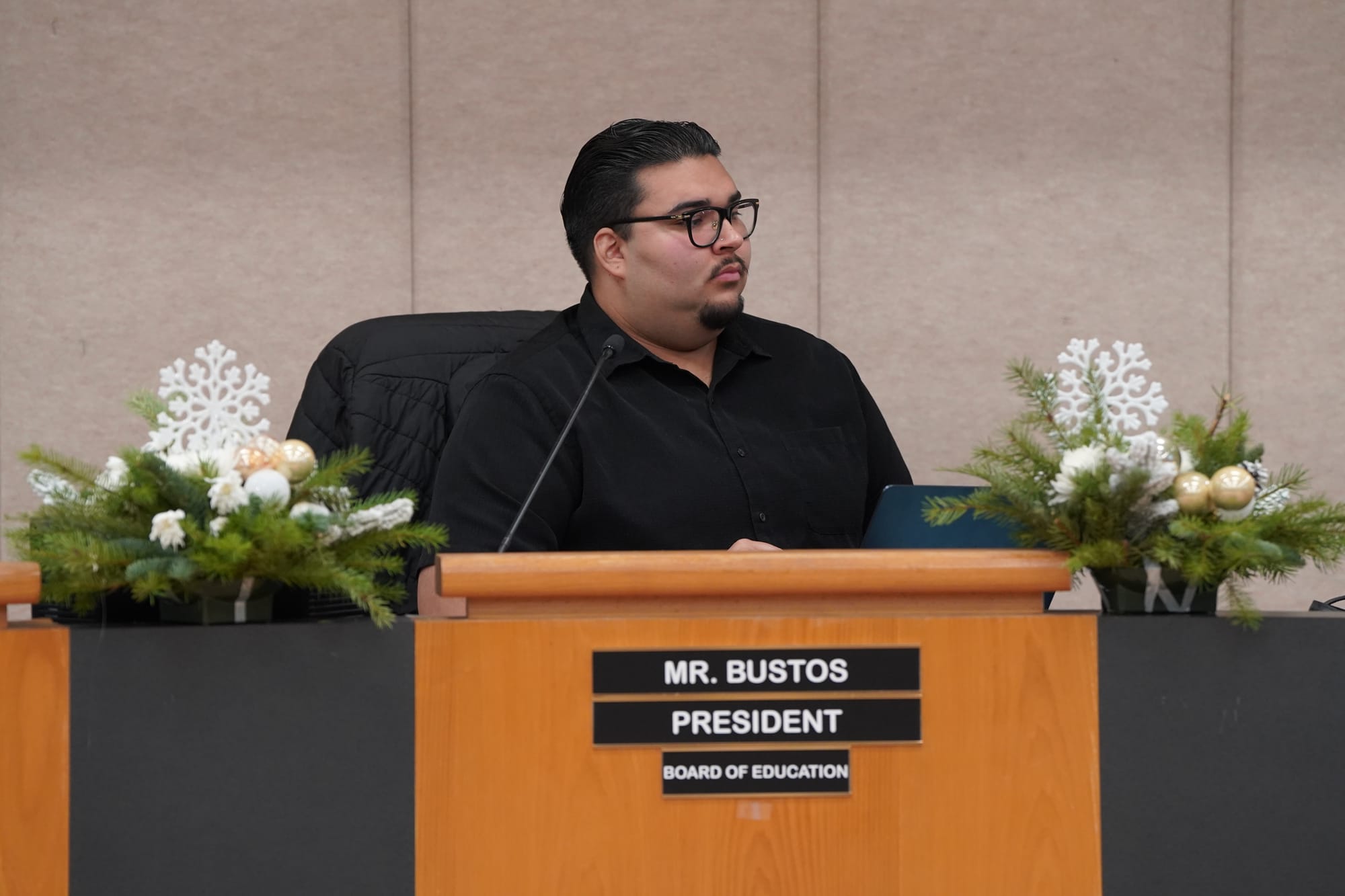
President Hector Bustos got emotional, echoing Madagleno's sentiments, adding that he was elected to ensure parents and the community have a board that is financially responsible, pointing to past boards, including when Mayor Amezcua sat on the board, suggesting they weren't.
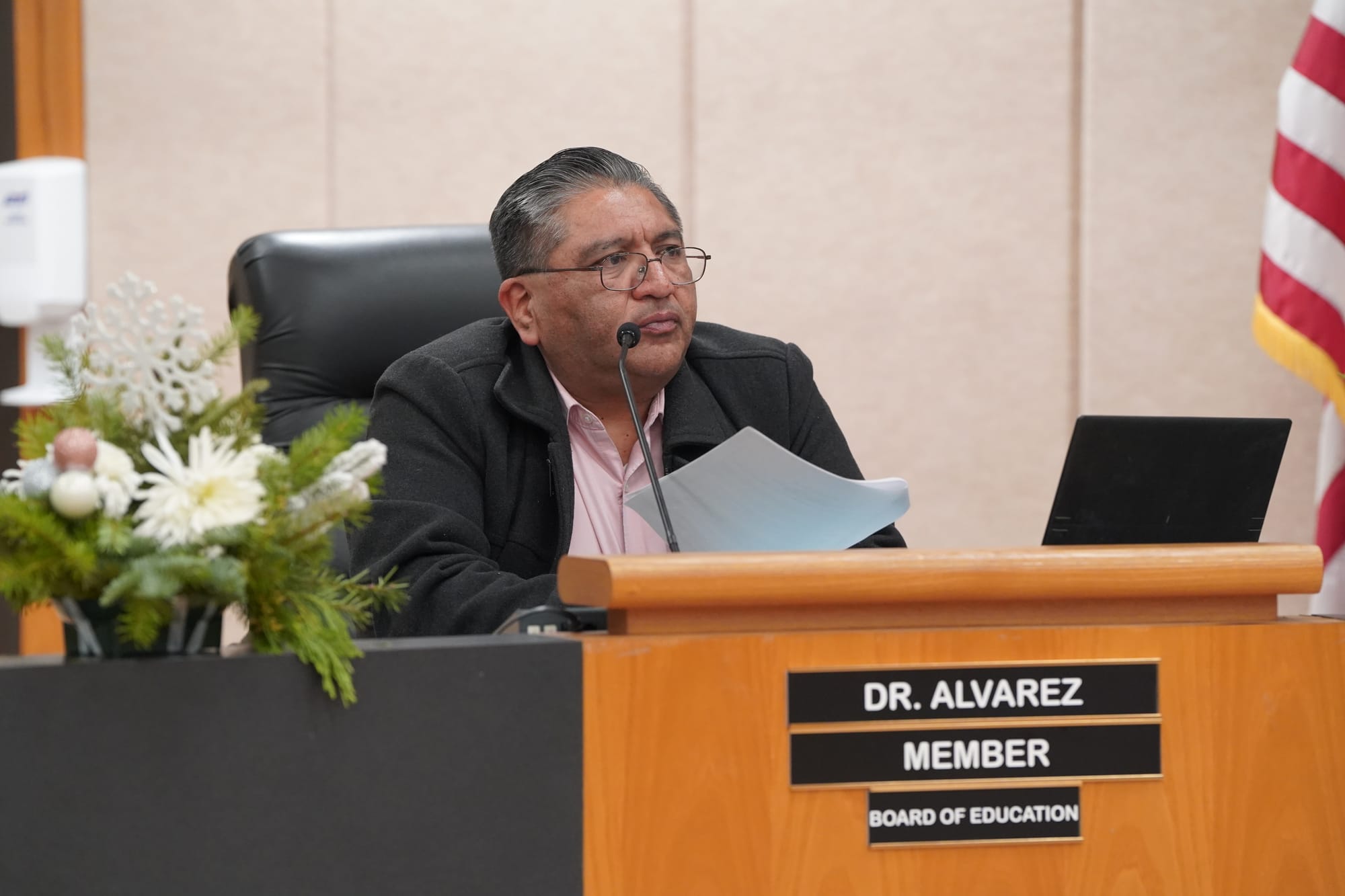
Dr. Alfonso Alvarez was concerned for how the changes would affect student learning, pointing to the District's emphasis on mental health during the pandemic.
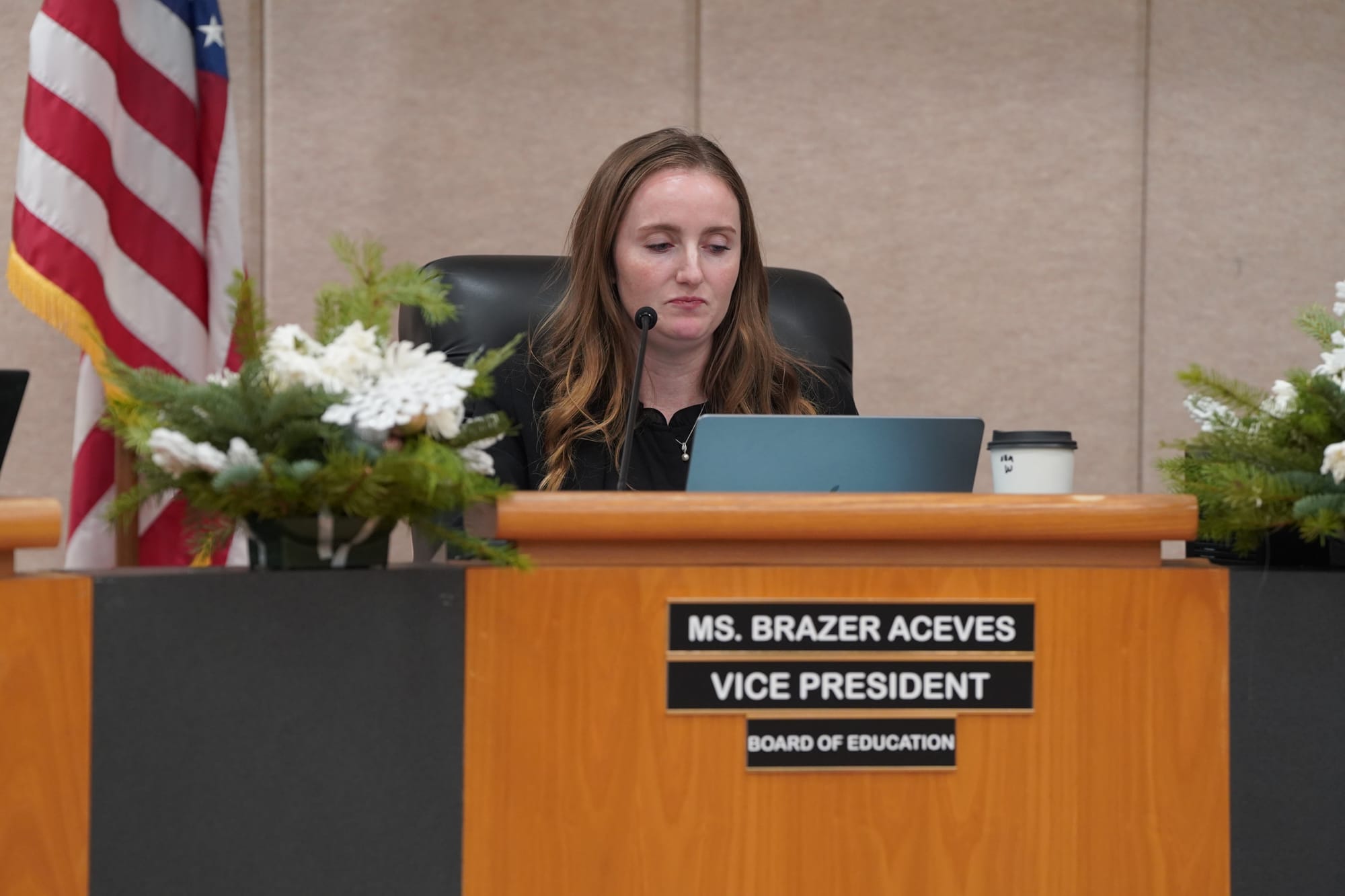
Katelyn Brazer-Aceves took a moment to thank Tuesday's speakers and those who expressed frustration, adding that their concerns were recognized.
"This a decision I don't take lightly," said Brazer-Aceves.
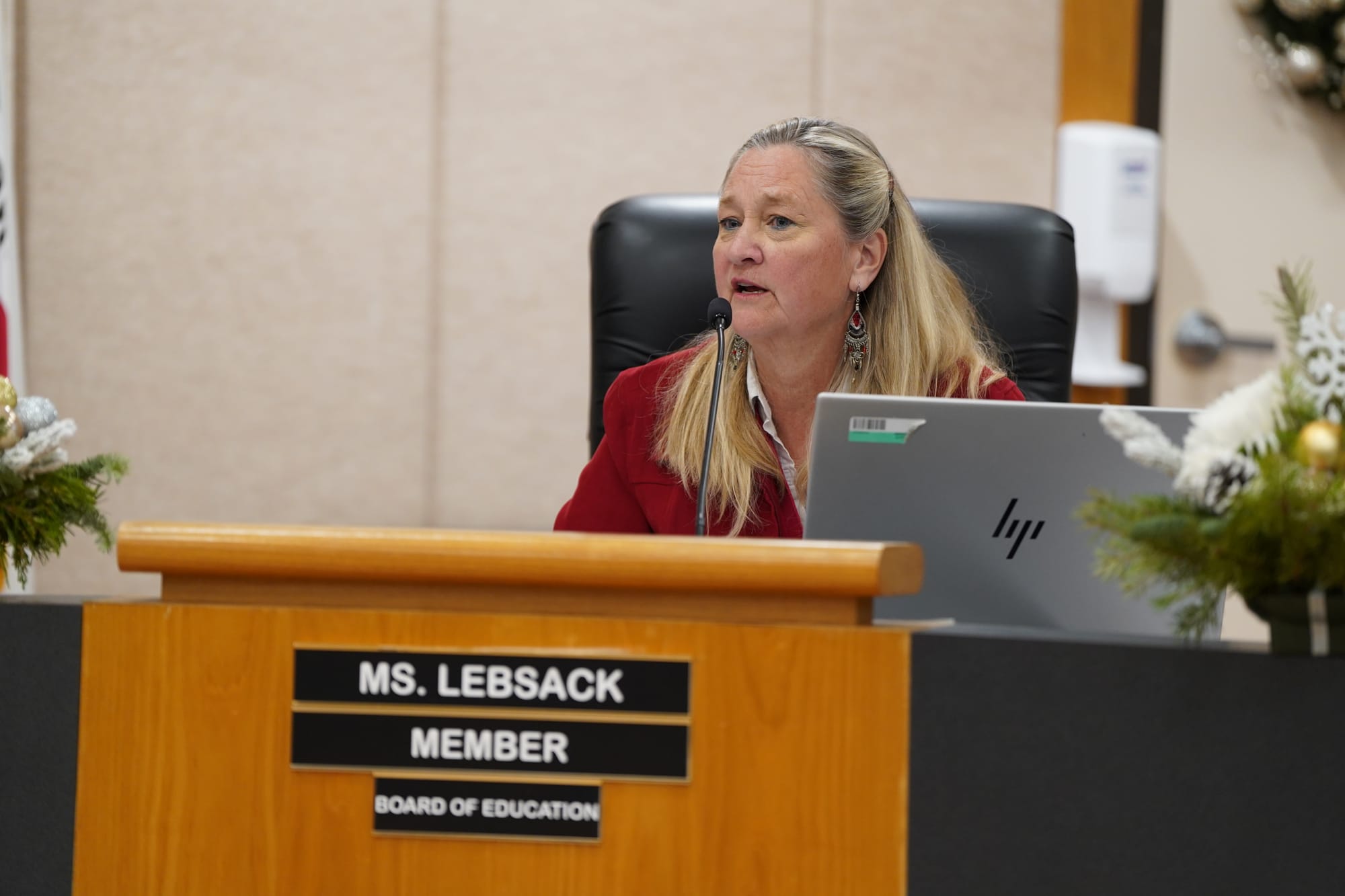
Brenda Lebsack, also recently sworn-in, asked CBO and Associate Superintendent Ronald Hacker if there was a maximum amount of layoffs.
He said no.
Hacker added that the amounts were based on projections of the first interim, a period of time in which the District is preparing their budgets for the next school year.
In response to a Board member's question, Hacker said he and his team did not look into pink-slipping current management at the District office, but rather said they'd look into the vacancies unfilled and likely close those.
No classified staff is projected to be laid off under the proposal. Classified staff are people who work directly with or for students whether it be in cafeterias, aides, and afterschool program leaders.
At a budget townhall meeting held virtually Wednesday, Hacker explained the District's budget futures, which look bleak.
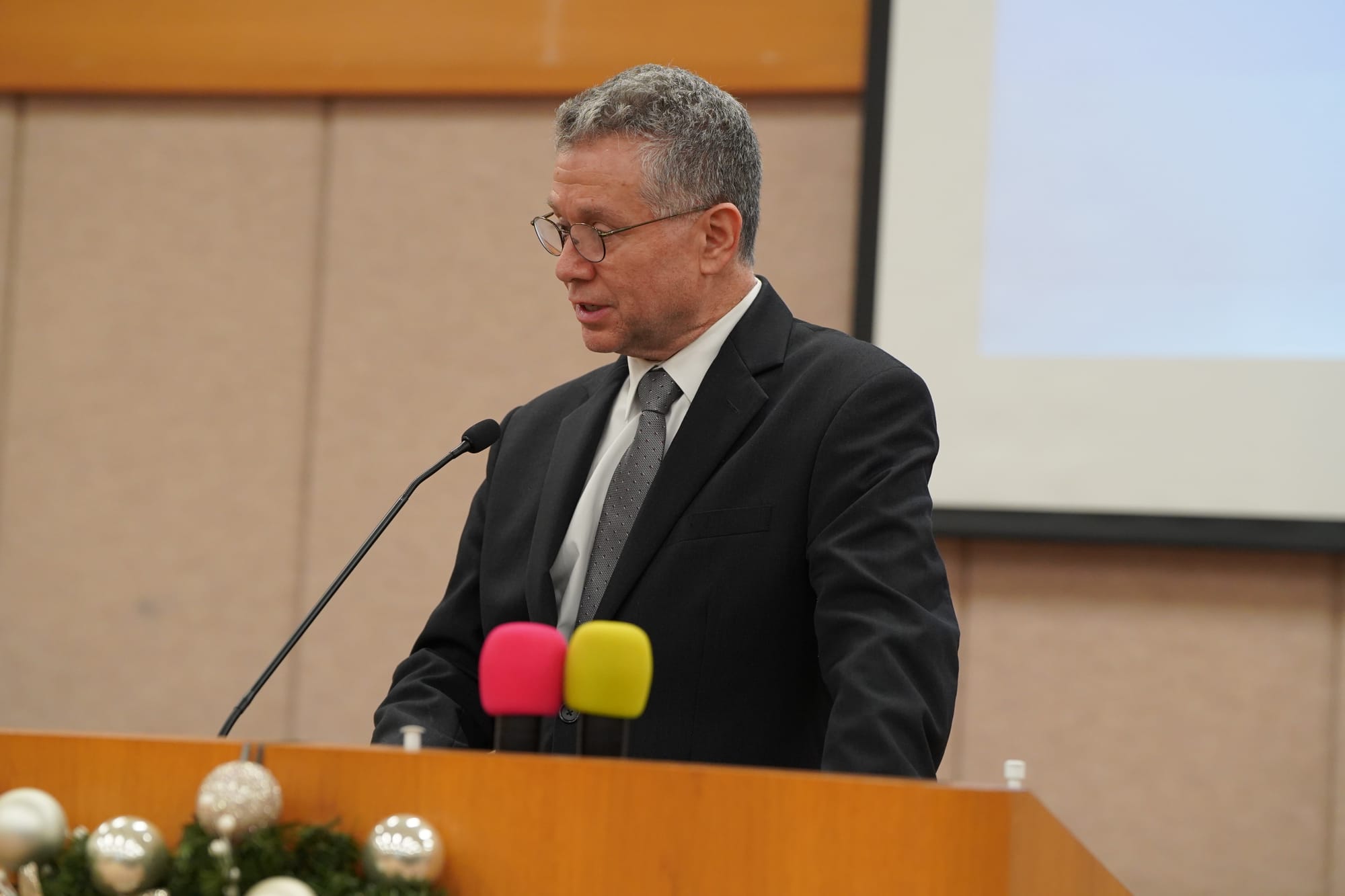
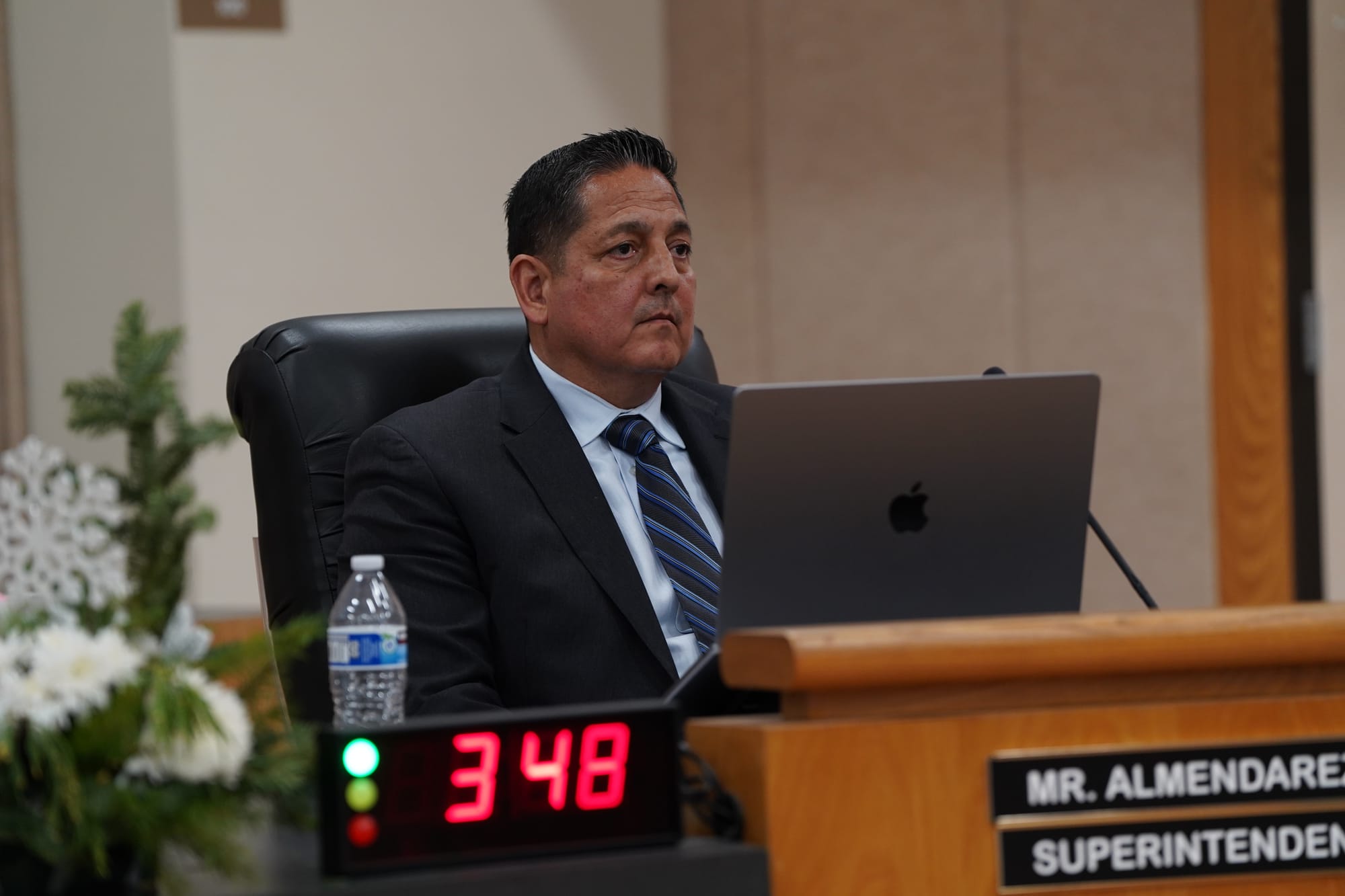
At left, CBO and Associate Superintendent Ronald Hacker. At right, Superintendent Jerry Almendarez. (Daniel Diaz/The Santanero)
Hacker and Superintendent Jerry Almendarez explained the history of the finances of SAUSD before the Board, saying cuts to staff were bound to happen, it was just a matter of when.
In 2017, the District laid off several certificated staff, due to declining enrollment. At the time, board member Cecilia Iglesias blamed the educators union for enflaming the financial situation, adding the union contract caused a $32 million increase in salaries for certificated staff.
Prior to the pandemic, again, the District found itself asking teachers and other non-management staff to retire early because another round of layoffs was imminent. When the District was to decide on pushing layoffs, COVID hit, an influx of monies came in from the government, and essentially paused layoffs, but it never stopped them for good.
The District received at least $402,071,696 of constricted COVID funds according to Wednesday's presentation, spending the most in 2021-22 and 2022-23—the school year in which classes returned in-person. It is at this point, Santa Ana Unified went on a hiring spree, allotting extra teachers, support staff, and hours attempting to swing students back into in-person learning, but in addition, was barred from laying off anyone by the State.
With the order from the State in place, SAUSD could not lay off anyone, but also had to use up the money within strict guidelines and prohibitions on what the monies could be used for. In other words, if it weren't for COVID, layoffs happening presently would have occurred in 2020.
Among the hundreds of tall metal air-filters now removed, gallons of hand sanitizer used, and weekly coronavirus tests done, the District's efforts in helping students resulted in having too much help among a slow progression in bouncing back from pre-pandemic levels regarding test scores, attendance, and enrollment.
The SAEA union
The Santa Ana Educators Association says it had been echoing those concerns from the beginning, that hiring people based on one-time funds would ultimately lead to layoffs.
"This is just the last example of district leadership’s disregard for the future of our students, educators, and public education in our city," said Santa Ana Educators Association President Sonta Garner-Marcelo. "Our district should invest in our classrooms, not tearing them apart. Our students have some of the greatest needs in the county, yet the district wants to cut services and support. This is a great way to push students out of school but a terrible way to support them."
When and if the District votes to layoff staff, at minimum, 14% of the SAEA bargaining unit would be dismissed, according to Garner-Marcelo.
Superintendent Almendarez was supposed to receive a 3% raise, but the Board decided to decide the item another day. Hacker added that even if it went to effect, the raise would not cause further disruption in the budget, and although all expenditures add up, the 3% would not change the outcome of cuts happening.
"This is a perfect example of how backward the priorities of District leadership are. Proposing devastating layoffs before the holidays should earn him a letter of termination, not a big raise, especially when he’s failing to earn his current annual compensation package of almost half a million dollars—$447,561," said Garner-Marcelo.
According to Transparent California, Almendarez received $447,561 in compensation in 2022. Before benefits, he received $385,655.00. A three percent raise would added $13,427 including benefits.
How much do people make at SAUSD?
In 2022, SAUSD's highest-paid employee was Superintendent Jerry Almendarez, earning a total of $447,561, according to OpenPayrolls. The Santa Ana Educators Association President at the time, Barbara Pearson, held the 5th highest-paid spot with $231,131.
For the School Board:
- Dr. Alfonso Alvarez, a board member, received $9,450 in 2022.
- Katlyn Brazer-Aceves, the Vice President, took office on Dec. 9, 2022, and likely earned around $787.50, as Transparent California has no records posted yet.
- Hector Bustos, the Board President, likely earned the same $787.50 in 2022 as he assumed office Dec. 9, 2022.
- Valerie Magdaleno, now the board clerk, worked as a program coordinator for the City of Santa Ana in 2022, earned $20,854 in total.
- Brenda Lebsack, now a board member, works as an adaptive physical education teacher and earned $142,982 in 2022.
For transparency, Ronald Hacker, who became the CBO and Associate Superintendent in 2023, has a contract listing an annual base salary of $252,348 (before benefits), making him one of the top 10 earners in the district.
Enrollment
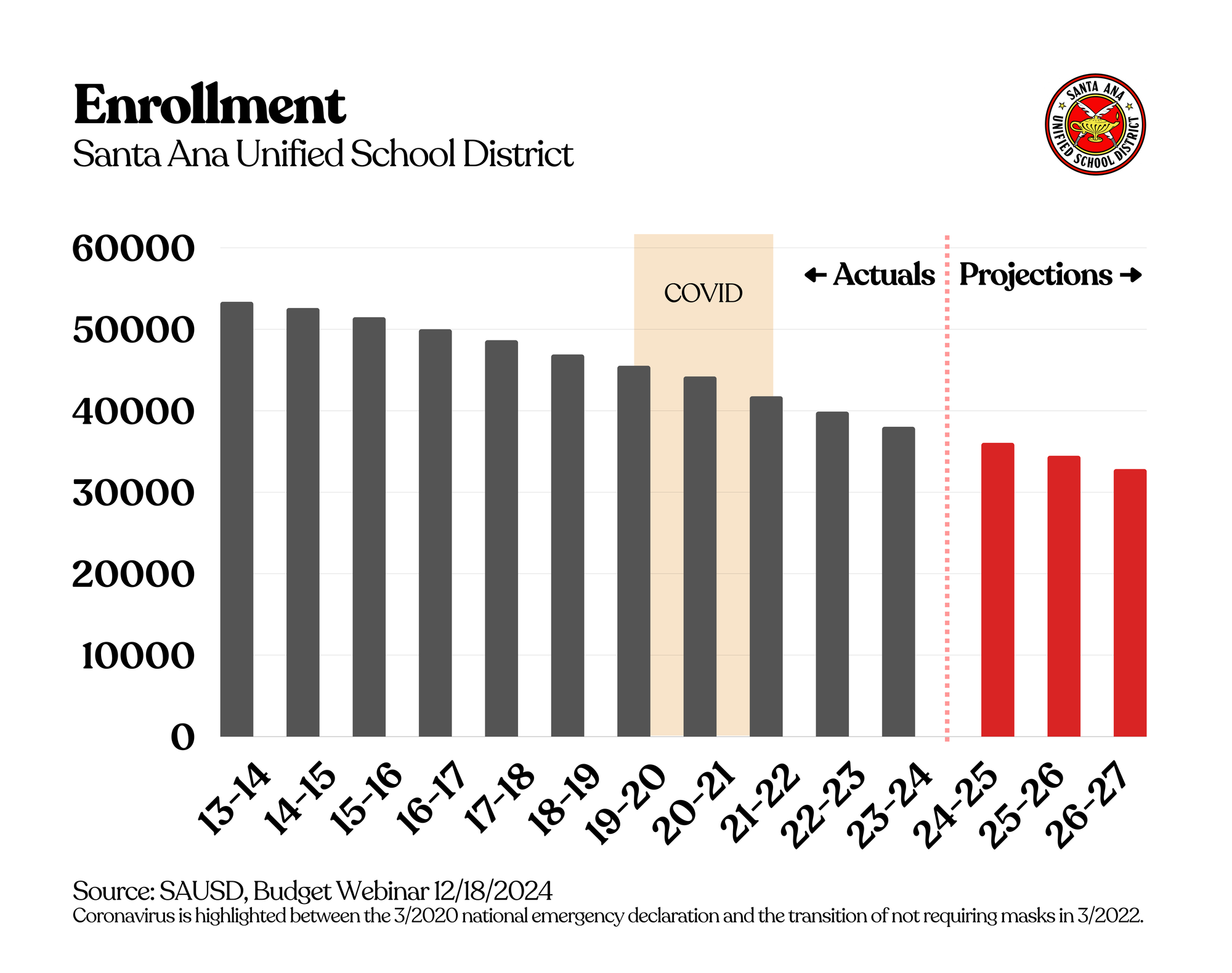
The problem of declining enrollment has been occurring since the early 2000's according to SAUSD census data. On average, the District has lost 1,396 students since 2013-14, the highest being 2,436 pupils during the first year of COVID.
State testing
Third, eighth, and 11th graders are benchmark tested annually which indicates where a school district stands in regard to state standards (stuff that students should have learned how to do). Most of the District's revenue comes from how the students perform in the assessments, alongside attendance.
Student state test scores indicate a positive trend since COVID, but SAUSD is still two years behind compared to the national 2019 average, almost a year behind the California state average.
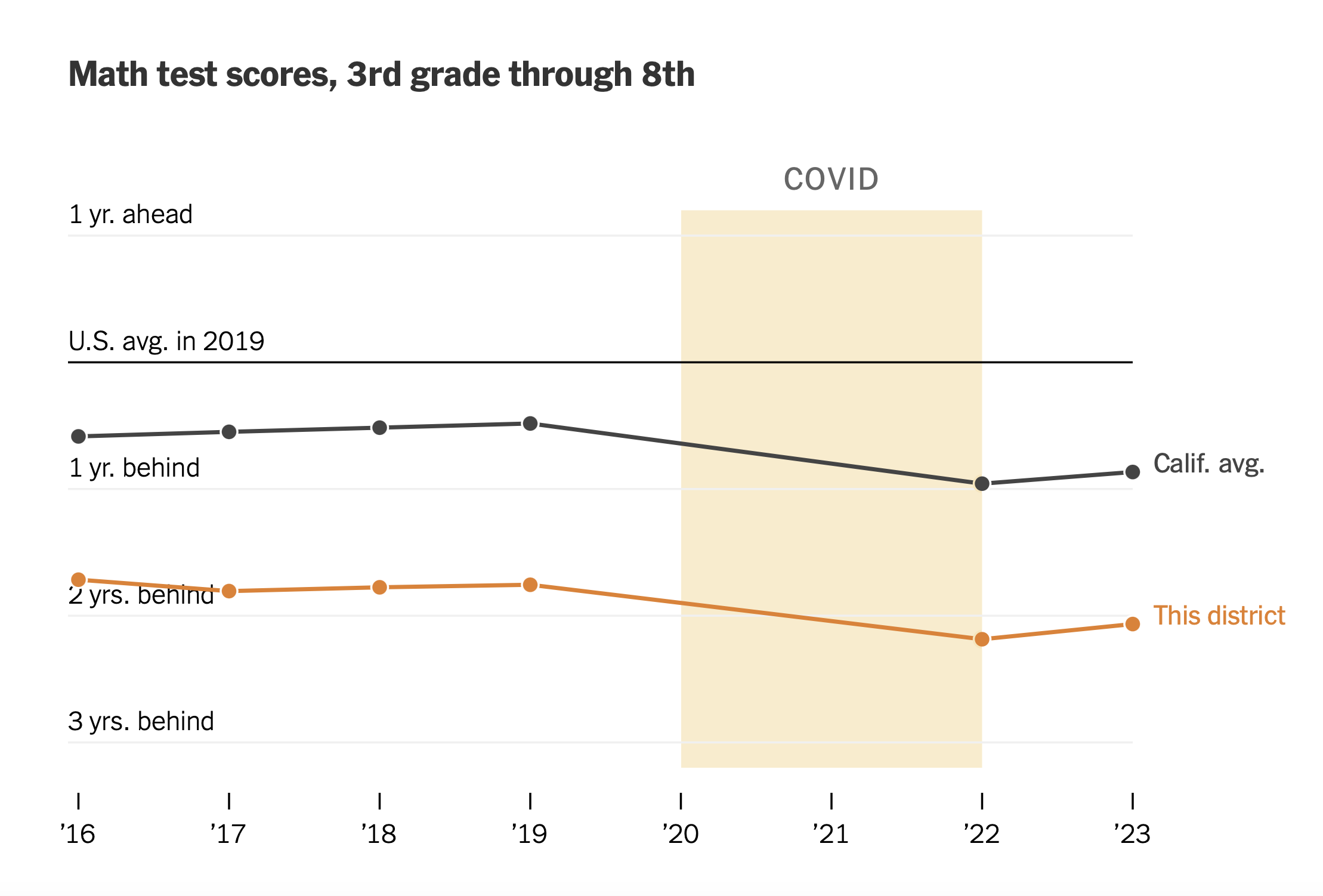
Locally, SAUSD ranks the lowest when compared to surrounding school districts.
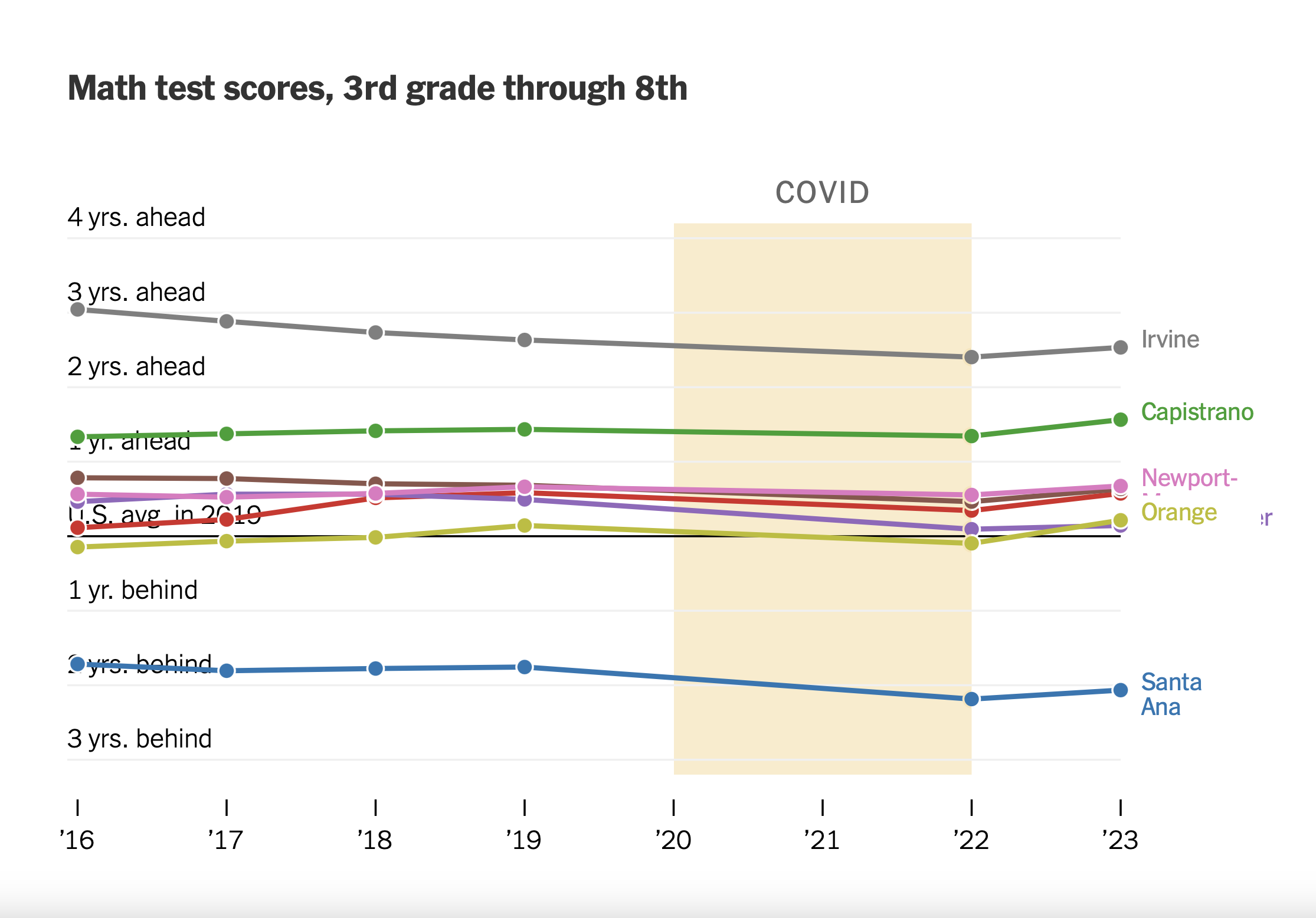
Nationally however, Santa Ana Unified isn't alone. More than half of districts nationwide are behind the 2019 national average based on 2023 test scores.
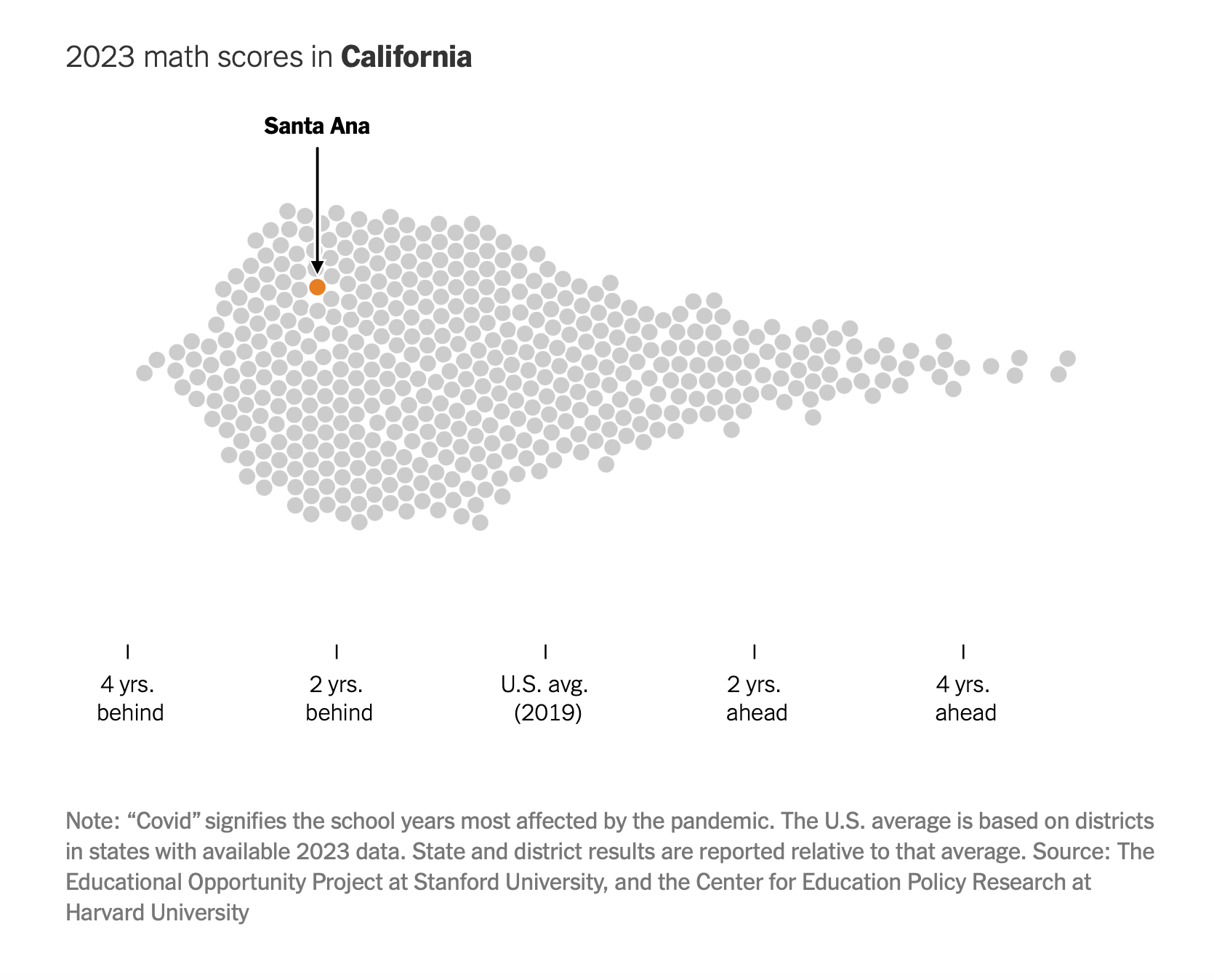
Tests results tell new parents on the block that are looking for schools to enroll their children in that a specific school district is ranking lower than others, which leads to a perception that lower rank school districts performing low in standardized tests essentially have students not learning.
Students play the key role in scores for the District that translates into funding later on by the State, aside from attendance rates, which chronic absenteeism persists statewide and at SAUSD.
Among the few reasons scores are low, students may feel overwhelmed and anxious. This is evidenced by testing blocks and dates all taking place back-to-back or with minimal breaks in between every spring.
These test scores create the perception that SAUSD public schools are failing, making it seem like teachers aren't doing their jobs and that the responsibility for Santa Ana students' struggles lies with the adults. This leads to the belief that raises aren't justified since the scores aren't improving.
This perception is enough to convince parents to enroll them elsewhere.
Revenue outlook
Revenue for SAUSD mainly comes from the Local Control Funding Formula, benchmarking districts statewide based on testing performance of their students. The more students in need of help, the more the District gets from what The Santanero understands.
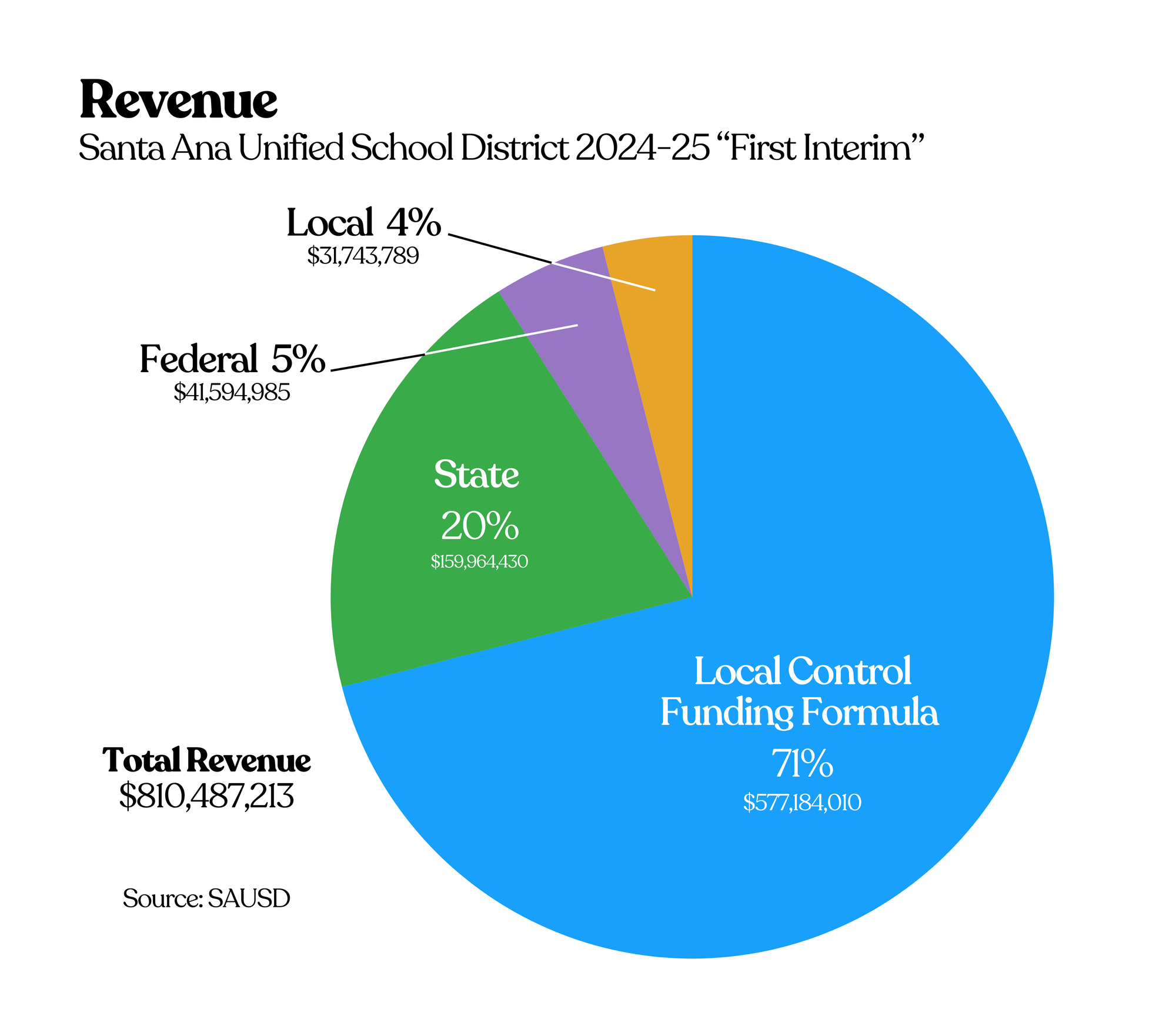
LCFF funds were shorten by 5% this school year due to enrollment numbers and stagnate absenteeism, leaving the District to source the money from federal resources.
More instability with the budget stems from the State and may shrink depending on California Gov. Gavin Newsom's proposed budget in late spring, which could lead to more cuts or layoffs at the District level.
What the community is saying?
The Santanero issued a snap poll and survey Thursday at 1:00 PM asking for surveyors to put themselves on the Board and what they would do.
28 participants took the survey, which isn't much to go on admittedly, but 28 spoke their opinion on the following:
- 92.8% say layoffs should not occur.
- 96.4% say they'd vote no on Superintendent Almendarez' raise.
- 60.7% they are not in favor of consolidating schools.
- 75% are in favor of capping or reducing the salaries of top paid District employees.
- 75% are in favor of auditing programs not helping enough people or reducing the number of programs doing the same thing.
- 71.4% are in favor of SAUSD working with the City and County for a "all hands on deck approach" to address budget reductions at all levels.
"Reduce wages of staff at the executive level so that we can keep our educational staff and programs running. We need teachers, not executive staff with enormous salaries!" said a participant said when asked about what they would do instead.
When asked about Alemendarez' 3% raise, a participant said "Meh. As a student I don’t really see what he has done for us."
















Discussion